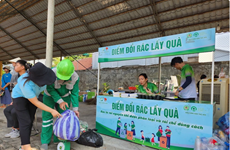Phong Nha-Ke Bang National Park’s preservation highlighted
Domestic and international experts gathered at a conference in the
central province of Quang Binh on May 23 to discuss the preservation and
promotion of scientific values of the World Heritage Site of Phong
Nha-Ke Bang National Park.
Domestic and international experts gathered at a conference in the
central province of Quang Binh on May 23 to discuss the preservation and
promotion of scientific values of the World Heritage Site of Phong
Nha-Ke Bang National Park.
The park marked the 10th anniversary of its recognition as a World Natural Heritage Site on geological and geomorphological criteria this month.
The conference heard 30 reports on measures to preserve and make use of the park’s values, as well as the Heritage site’s impacts on local socio-economic development.
The speakers also discussed biological values of the site, looking towards an application for another World Heritage title in terms of biodiversity, and the sustainable development of tourism in the park.
Dr. Tran Tien Dung, Vice Chairman of the Quang Binh People’s Committee said the province has applied synchronous measures to conserve and develop natural advantages of the site, while minimising the tourism overload.
Located in Bo Trach district, Phong Nha-Ke Bang National Park covers an area of 85,754 hectares and a buffer zone of 195,400 hectares. It is among the 238 most important ecological zones in the world.
The property contains and protects over 104 km of caves and underground rivers making it one of the most outstanding limestone karst ecosystems in the world. The karst formation has evolved since the Palaeozoic period (some 400 million years ago) and as such is the oldest major karst area in Asia.
A large number of faunal and floral species occur within the property with 849 vertebrate species recorded. This impressive level of biodiversity and species richness includes a number of endemic species as well as threatened species including tiger, Asiatic black bear, Asian elephant, giant muntjac, Asian wild dog, gaus and the recently discovered sao la.
In particular, 19 new species have been discovered in the park, including 14 reptiles, an amphibian, two kinds of scorpions and one bird.-VNA
The park marked the 10th anniversary of its recognition as a World Natural Heritage Site on geological and geomorphological criteria this month.
The conference heard 30 reports on measures to preserve and make use of the park’s values, as well as the Heritage site’s impacts on local socio-economic development.
The speakers also discussed biological values of the site, looking towards an application for another World Heritage title in terms of biodiversity, and the sustainable development of tourism in the park.
Dr. Tran Tien Dung, Vice Chairman of the Quang Binh People’s Committee said the province has applied synchronous measures to conserve and develop natural advantages of the site, while minimising the tourism overload.
Located in Bo Trach district, Phong Nha-Ke Bang National Park covers an area of 85,754 hectares and a buffer zone of 195,400 hectares. It is among the 238 most important ecological zones in the world.
The property contains and protects over 104 km of caves and underground rivers making it one of the most outstanding limestone karst ecosystems in the world. The karst formation has evolved since the Palaeozoic period (some 400 million years ago) and as such is the oldest major karst area in Asia.
A large number of faunal and floral species occur within the property with 849 vertebrate species recorded. This impressive level of biodiversity and species richness includes a number of endemic species as well as threatened species including tiger, Asiatic black bear, Asian elephant, giant muntjac, Asian wild dog, gaus and the recently discovered sao la.
In particular, 19 new species have been discovered in the park, including 14 reptiles, an amphibian, two kinds of scorpions and one bird.-VNA













